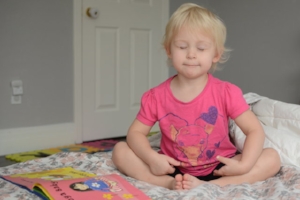One of Calma’s Mindful Parenting Workshops focuses on Mindfulness as a preventative behavioral approach for toddlers and kids. Most of the research comes from these two books: The Whole Brain Child and No Drama Discipline, both of which I HIGHLY recommend. We are living in a fascinating time when it comes to the brain. Due to advances in technology, we now know so much about what is happening in the brain in response to our environment, including what is happening in a child’s brain before, during and after tantrums. The authors use the latest research to provide practical, firm and loving approaches to tackling these terrible tantrums based on what we now know about a child’s brain.
I, for one, was so happy to revisit this information because I am in the thick of it with my two-year-old. A couple years ago, I wrote a blog post about these two books called The Rules of Two to Tackle the Terrible, Terrible-Twos, not because I was desperate for the information for the sanity of my household, but because I was desperate to learn about tantrums and melt-down for my sanity at work. So much of their research explained exactly what I was seeing from 5-7-year-olds as a behavior interventionist. I would see kids go from being just a little bit upset because someone had stolen their pencil to knocking over desks, kicking down chairs and running out of the room and down the hallway in a matter of seconds. Nine times out of ten, once the child had calmed down, he (or she) would usually start bawling, feeling terrible for exhibiting such a reaction. He didn’t want to react this way, but once he began to escalate, there was no stopping it.

The authors, Dr. Tina Payne Bryson and Daniel Siegel explain that this type of tantrum describes a “downstairs brain” tantrum where a child completely loses his mind, literally. We’ve all seen it. And, the way we approach this type of tantrum is completely different than the way we approach a child who is negotiating, arguing or trying to convince because two different parts of the brain are at work in these situations. When a child loses it, the amygdala has taken over the brain, and that child cannot calm down without connection from the adult. Counting, threatening, yelling, or giving one.last.chance. will never work here because the reasoning part of the child’s brain has been taken over by the part of the brain that is supposed to protect the child. Until that amygdala monster is tamed, there is no moving forward. The authors suggest remaining calm and connecting with your child by holding them, using a soothing voice, singing and breathing slowly.
An “upstairs tantrum”, on the other hand, is when a child is choosing to terrorize you. You can tell this type of tantrum because, no matter how ridiculously out-of-control he or she seems, if your child is negotiating or arguing with you, trying to manipulate or convince you, they are using their upstairs brain. They are physically able to control their emotions and body, to be logical, and make good decisions. In this case, the authors recommend: never, ever negotiate with a terrorist. This calls for firm boundaries, and a clear discussion about appropriate and inappropriate behavior.
With either type of tantrum, self-regulation skills are so important for your child. If it is an upstairs brain tantrum, calming down can prevent the tantrum from escalating to public embarrassment. If it is a downstairs brain tantrum, self-regulation is the only way a child will be able to calm down. But, the key is to practice these skills before they find themselves in either situation. Self-Regulation (being able to regulate your emotions once they begin to escalate) is hard for even most adults, and our brains are fully developed to handle such situations. I learned this the hard way as a behavior interventionist. I, just like most other adults, would tell children to “just calm down”. It wasn’t until I realized that calming down is a skill that has to be taught that I had much success with my challenging little friends. Imagine if we expected our kids to know how to solve math problems, or to spell without teaching them. Self-regulation skills are not something that come naturally to children; they must be taught.

Just like we practice our jump shot for the big game over and over, we must practice these skills of self-regulation consistently and often if we want it to be effective when the big emotions start to come. “Unless you incorporate a resistance plan into the hot system (the amygdala), it is unlikely to be activated when you need it most. That is because as emotional arousal and stress increase, the hot system is accelerated,” says Walter Mischel in his book The Marshmallow Test, Mastering Self-Control. I, personally, have my daughter practice belly breathing with Elmo, Common and Colbie Caillat, using the below video, at least once a day. Has this practice stopped all tantrums? Nope. But, it’s definitely helped. She can now take some breaths as she begins to escalate during an upstairs brain tantrum, and she’s able to get back to normal faster when the amygdala monster takes over. For breathing audio for children click here or enjoy using the video below. And, on behalf of all the educators out there, thank you for taking the time to equip your child with this skill.
